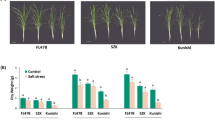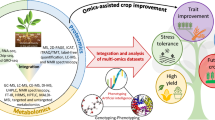Abstract
Aluminum (Al) toxicity is a major factor that limits crop productivity in acid soils. The toxic effects of Al exposure on Al-tolerant Cryptococcus humicola were analyzed at the physiological level. The exposure to 20 mM Al led to a clear increase in malondialdehyde content and a significant decrease in the levels of protein carbonyls, suggesting that Al stress caused oxidative damage to membrane lipids but not to proteins. Suppression subtractive hybridization (SSH) results showed that when C. humicola was exposed to 20 mM Al, a total of 141 ESTs were differentially expressed. Of them, 27 had unknown functions and 48 were newly identified in this study. The genes with known functions were categorized into seven groups. The largest group was related to metabolism and energy, followed by protein synthesis and processing, cell structure, signal transduction and transcription, transporters, stress and defense. Reverse transcription (RT)-PCR analysis of certain genes was performed to confirm the reliability of the SSH data. Nine selected genes were upregulated by Al in a time-dependent manner. The potential functions of some genes involved in Al-tolerance were predicted and are discussed. The diversity of the putative functions of these genes indicates that Al stress results in a complex response in C. humicola.





Similar content being viewed by others
References
Anoop VM, Basu U, McCammon MT, McAlister-Henn L, Taylor GJ (2003) Modulation of citrate metabolism alters aluminum tolerance in yeast and transgenic canola overexpressing a mitochondrial citrate synthase. Plant Physiol 132:2205–2217
Basu U, Southron JL, Stephens JL, Taylor GJ (2004) Reverse genetic analysis of the glutathione metabolic pathway suggests a novel role of PHGPX and URE2 genes in aluminum resistance in Saccharomyces cerevisiae. Mol Genet Genomics 271:627–637
Brosche M, Strid A (1999) Cloning, expression, and molecular characterization of a small pea gene family regulated by low levels of ultraviolet B radiation and other stresses. Plant Physiol 121:479–487
Cabib E, Drgonova J, Drgon T (1998) Role of small G proteins in yeast cell polarization and wall biosynthesis. Annu Rev Biochem 67:307–333
Chandran D, Sharopova N, Ivashuta S, Gantt JS, Vandenbosch KA, Samac DA (2008a) Transcriptome profiling identified novel genes associated with aluminum toxicity, resistance and tolerance in Medicago truncatula. Planta 228:151–166
Chandran D, Sharopova N, VandenBosch KA, Garvin DF, Samac DA (2008b) Physiological and molecular characterization of aluminum resistance in Medicago truncatula. BMC Plant Biol 8:89
Chen LS, Qi YP, Liu XH (2005) Effects of aluminum on light energy utilization and photoprotective systems in citrus leaves. Ann Bot 96:35–41
Chen Q, Zhang XD, Wang SS, Wang QF, Wang GQ, Nian HJ, Li KZ, Yu YX, Chen LM (2011) Transcriptional and physiological changes of alfalfa in response to aluminium stress. J Agric Sci 149:737–751
Cruz-Ortega R, Cushman JC, Ownby JD (1997) cDNA clones encoding 1, 3-β-glucanase and a wmbrin-like cytoskeletal protein are induced by Al toxicity in wheat roots. Plant Physiol 114:1453–1460
da Silva AL, Sperling P, Horst W, Franke S, Ott C, Becker D, Stass A, Lörz H, Heinz E (2006) A possible role of sphingolipids in the aluminium resistance of yeast and maize. J Plant Physiol 163(1):26–38
Darko É, Ambrus H, Stefanovits-banyai É, Fodor J, Bakos F, Barnabas B (2004) Aluminium toxicity, Al tolerance and oxidative stress in an Al-sensitive wheat genotype and in Al-tolerant lines developed by in vitro microspore selection. Plant Sci 166:583–591
Deng W, Luo K, Li D, Zheng X, Wei X, Smith W, Thammina C, Lu L, Li Y, Pei Y (2006) Overexpression of an Arabidopsis magnesium transport gene, AtMGT1, in Nicotiana benthamiana confers Al tolerance. J Exp Bot 57:4235–4243
Devi SR, Yamamoto Y, Matsumoto H (2003) An intracellular mechanism of aluminum tolerance associated with high antioxidant status in cultured tobacco cells. J Inorg Biochem 97:59–68
Eleftheriou E, Moustakas M, Fragiskos N (1993) Aluminate induced changes in morphology and ultrastructure of Thinopyrum roots. J Exp Bot 44:427–436
Ermolayev V, Weschke W, Manteuffel R (2003) Comparison of Al-induced gene expression in sensitive and tolerant soybean cultivars. J Exp Bot 54:2745–2756
Goodwin SB, Sutter TR (2009) Microarray analysis of Arabidopsis genome response to aluminum stress. Biol Plantarum 53:85–99
Guo TR, Zhang GP, Zhang YH (2007) Physiological changes in barley plants under combined toxicity of aluminum, copper and cadmium. Colloids Surf B Biointerfaces 57:182–188
Gurel A, Coskun O, Armutcu F, Kanter M, Ozen OA (2005) Vitamin E against oxidative damage caused by formaldehyde in frontal cortex and hippocampus: biochemical and histological studies. J Chem Neuroanat 29:173–178
Hamilton CA, Good AG, Taylor GJ (2001a) Induction of vacuolar ATPase and mitochondrial ATP synthase by aluminum in an aluminum-resistant cultivar of wheat. Plant Physiol 125:2068–2077
Hamilton CA, Good AG, Taylor GJ (2001b) Vacuolar H+-ATPase, but not mitochondrial F1F10-ATPase, is required for aluminum resistance in Saccharomyces cerevisiae. FEMS Microbiol Lett 205:231–236
Hazel JR (1995) Thermal adaptation in biological membranes: is homeoviscous adaptation the explanation? Annu Rev Physiol 57:19–42
Iuchi S, Koyama H, Iuchi A et al (2007) Zinc finger protein STOP1 is critical for proton tolerance in Arabidopsis and coregulates a key gene in aluminum tolerance. Proc Natl Acad Sci USA 104:9900–9905
Kakimoto M, Kobayashi A, Fukuda R, Ono Y, Ohta A, Yoshimura E (2005) Genome-wide screening of aluminum tolerance in Saccharomyces cerevisiae. Biometals 18:467–474
Kawai F, Zhang D, Sugimoto M (2000) Isolation and characterization of acid- and Al-tolerant microorganisms. FEMS Microbiol Lett 189:143–147
Kawasaki S, Borchert C, Deyholos M, Wang H, Brazille S, Kawai K, Galbraith D, Bohnert HJ (2001) Gene expression profiles during the initial phase of salt stress in rice. Plant Cell 13:889–906
Komatsu S, Konishi H (2005) Proteome analysis of rice root proteins regulated by gibberellins. Genomics Proteomics Bioinform 3:132–142
Kumari M, Taylor GJ, Deyholos MK (2008) Transcriptomic responses to aluminum stress in roots of Arabidopsis thaliana. Mol Genet Genomics 279:339–357
Kurita H, Nakatomi A, Shimahara H, Yazawa M, Ohki S (2005) Al3+ interaction sites of calmodulin and the Al3+ effect on target binding of calmodulin. Biocheml Biophys Res Commun 333:1060–1065
Larsen PB, Geisler MJ, Jones CA, Williams KM, Cancel JD (2005) ALS3 encodes a phloem-localized ABC transporter-like protein that is required for aluminum tolerance in Arabidopsis. Plant J 41:353–363
Leubner-Metzger G, Meins FJ (1999) Functions and regulation of plant β-1, 3-glucanases (PR-2). In: Datta SK, Muthukrishnan S (eds) Pathogenesis-related proteins in plants. CRC Press, Boca Raton, pp 49–76
Li X, Qian J, Wang C, Zheng K, Ye L, Fu Y, Han N, Bian H, Pan J, Wang J, Zhu M (2011) Regulating cytoplasmic calcium homeostasis can reduce aluminum toxicity in yeast. PLoS ONE 6(6):e21148
MacDiarmid CW, Gardner RC (1998) Overexpression of the Saccharomyces cerevisiae magnesium transport system confers resistance to aluminum ion. J Biol Chem 273:1727–1732
Madden K, Snyder M (1998) Cell polarity and morphogenesis in budding yeast. Annu Rev Microbiol 52:687–744
Mao C, Yi K, Yang L, Zheng B, Wu Y, Liu F, Wu P (2004) Identification of aluminum-regulated genes by cDNA-AFLP in rice (Oryza sativa L.): aluminum-regulated genes for the metabolism of cell wall components. J Exp Bot 55:137–143
Milla MA, Butler E, Huete AR, Wilson CF, Anderson O, Gustafson JP (2002) Expressed sequence tag-based gene expression analysis under aluminum stress in rye. Plant Physiol 130:1706–1716
Osawa H, Matsumoto H (2001) Possible involvement of protein phosphorylation in aluminum-responsive malate efflux from wheat root apex. Plant Physiol 126:411–420
Rengel Z, Zhang WH (2003) Role of dynamics of intracellular calcium in aluminium-toxicity syndrome. New Phytol 159:295–314
Richards KD, Schott EJ, Sharma YK et al (1998) Aluminum induces oxidative stress genes in Arabidopsis thaliana. Plant Physiol 116:409–418
Sasaki M, Yamamoto Y, Matsumoto H (1996) Ligin deposition induced by aluminium in wheat (Triticum aestivum) roots. Physiol Plantarum 96:193–198
Sasaki T, Yamamoto Y, Ezaki B, Katsuhara M, Ahn SJ, Ryan PR, Delhaize E, Matsumoto H (2004) A wheat gene encoding an aluminum-activated malate transporter. Plant J 37:645–653
Schmidt A, Hall MN (1998) Signaling to the actin cytoskeleton. Annu Rev Cell Dev Biol 14:305–338
Schott EJ, Gardner RC (1997) Aluminum-sensitive mutants of Saccharomyces cerevisiae. Mol Gen Genet 254:63–72
Shen H, He LF, Sasaki T, Yamamoto Y, Zheng SJ, Ligaba A, Yan XL, Ahn SJ, Yamaguchi M, Sasakawa H, Matsumoto H (2005) Citrate secretion coupled with the modulation of soybean root tip under aluminum stress. Up-regulation of transcription, translation, and threonine-oriented phosphorylation of plasma membrane H+-ATPase. Plant Physiol 138:287–296
Singh R, Beriault R, Middaugh J, Hamel R, Chenier D, Appanna VD, Kalyuzhnyi S (2005) Aluminum-tolerant Pseudomonas fluorescens: ROS toxicity and enhanced NADPH production. Extremophiles 9:367–373
Sivaguru M, Ezaki B, He ZH, Tong H, Osawa H, Baluska F, Volkmann D, Matsumoto H (2003) Aluminum-induced gene expression and protein localization of a cell wall-associated receptor kinase in Arabidopsis. Plant Physiol 132:2256–2266
Sugimoto M, Sakamoto W (1997) Putative phospholipid hydroperoxide glutathione peroxidase gene from Arabidopsis thaliana induced by oxidative stress. Genes Genet Syst 72:311–316
Tani A, Zhang D, Duine JA, Kawai F (2004) Treatment of the yeast Rhodotorula glutinis with AlCl3 leads to adaptive acquirement of heritable aluminum resistance. Appl Microbiol Biotechnol 65:344–348
Tesfaye M, Temple SJ, Allan DL, Vance CP, Samac DA (2001) Overexpression of malate dehydrogenase in transgenic alfalfa enhances organic acid synthesis and confers tolerance to aluminum. Plant Physiol 127:1836–1844
Watt DA (2003) Aluminium-responsive genes in sugarcane: identification and analysis of expression under oxidative stress. J Exp Bot 54:1163–1174
Wu Y, Wang Q, Ma Y, Chu C (2005) Isolation and expression analysis of salt up-regulated ESTs in upland rice using PCR-based subtractive suppression hybridization method. Plant Sci 168:847–853
Zaragoza O, Chrisman CJ, Castelli MV et al (2008) Capsule enlargement in Cryptococcus neoformans confers resistance to oxidative stress suggesting a mechanism for intracellular survival. Cell Microbiol 10:2043–2057
Zheng J, Zhao JF, Tao YZ et al (2004) Isolation and analysis of water stress induced genes in maize seedlings by subtractive PCR and cDNA macroarray. Plant Mol Biol 55:807–823
Zheng K, Pan JW, Ye L et al (2007) Programmed cell death involved aluminum toxicity in yeast alleviated by antiapoptotic members with decreased calcium signals. Plant Physiol 143:38–49
Acknowledgments
This work was supported by the foundation of the National Basic Research Program of China (2007CB108901), by the National Natural Science Foundation of China (31160020), and by the Application of Basic Research Foundation (2009ZC014X) from Yunnan province.
Author information
Authors and Affiliations
Corresponding author
Additional information
Hongjuan Nian and Geqi Wang have contributed equally to this work.
Electronic supplementary material
Below is the link to the electronic supplementary material.
Rights and permissions
About this article
Cite this article
Nian, H., Wang, G. & Chen, L. Physiological and transcriptional analysis of the effects of aluminum stress on Cryptococcus humicola . World J Microbiol Biotechnol 28, 2319–2329 (2012). https://doi.org/10.1007/s11274-012-1039-9
Received:
Accepted:
Published:
Issue Date:
DOI: https://doi.org/10.1007/s11274-012-1039-9




